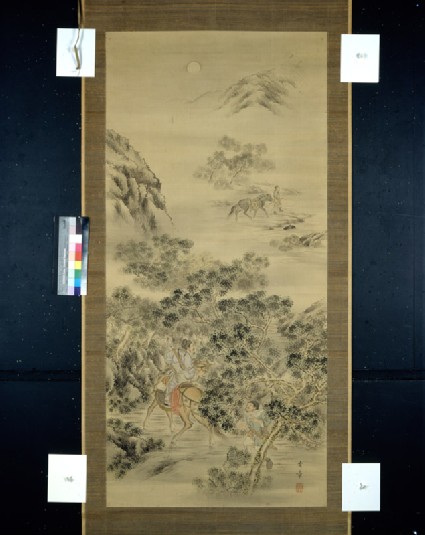Browse: 10610 objects
- Reference URL
Actions
Shōka following the warrior Kanshin by moonlight
-
Details
- Associated place
-
Asia › Japan › Honshū › Kyōto prefecture › Kyoto (possible place of creation)
- Date
- 2nd half of the 18th century
- Artist/maker
-
Nakajima Yūshō (1837 - 1905) (artist)Maruyama-Shijō School (active late 18th century - late 19th century)
- Material and technique
- ink and colour on silk
- Dimensions
- 124 x 57.5 cm (height x width)
- Material index
-
organic › animal › animal product › silk,
- Technique index
- Object type index
- No. of items
- 1
- Credit line
- Purchased with the assistance of the Friends of the Ashmolean, and Mr and Mrs J. Hillier, 1973.
- Accession no.
- EA1973.184
-
Further reading
Katz, Janice, Japanese Paintings in the Ashmolean Museum, Oxford, with an introductory essay by Oliver Impey (Oxford: Ashmolean Museum, 2003), no. 42 on p. 148, p. 85, illus. p. 149
Location
-
- currently in research collection
Objects are sometimes moved to a different location. Our object location data is usually updated on a monthly basis. Contact the Jameel Study Centre if you are planning to visit the museum to see a particular object on display, or would like to arrange an appointment to see an object in our reserve collections.
Publications online
-

Japanese Paintings in the Ashmolean Museum
Yushō is much less well known than his teacher Nakajima Raishō as an artist of the Maruyama school of painting in Kyoto at the end of the nineteenth century. Like Raishō, he excelled in painting horses.
The story seen here is one of two Chinese heroes of the Han dynasty (206 BC-AD 220). Of his own accord, the local official Shōka has set out to bring back the warrior Kanshin. After not eating for three days during his pursuit, we see the moment when Shōka first catches sight of Kanshin. Upon their return, Shōka is scolded by Duke Liu Bang (J: Ryūhō) for leaving without permission, especially to go after such a useless man when Shōka himself is so vital. Shōka explains that Kanshin is an excellent warrior, and while others may run away and return, once Kanshin leaves he would be gone forever. Liu is then persuaded to make Kanshin a general of the highest level. With the help of Kanshin’s ability in the battlefield, Liu becomes the emperor and founder of the Han dynasty.
The legend of Shōka and Kanshin can also be seen on Chinese porcelain [see Toyamasu Yasumasa, ‘Chūgoku tōji ni miru moyō (12)- Jinbutso (6)- Shōka to Kanshin’, in Tōsetsu 560, 54-6], and probably made its way to Japan on such objects or as the subject of woodblock printed illustrations. In the Edo period, the story was taken up by Japanese artists such as Yosa Buson in one side of a pair of six-fold screens [published in Toda Teisuke et al., Kangakei jinbutsu, Nihon byōbu-e shūsei, vol. 3 plates 62, 63, pages 68, 139-40].
© 2013 University of Oxford - Ashmolean Museum

